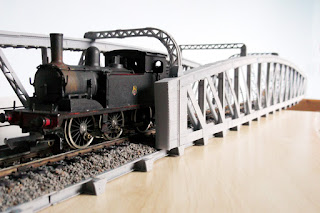There is something odd about the angled struts in the centre span of the bridge seen today.
Looking left to right:
Strut 1, whilst having cross bracing like some of the others, is unique in that its sides are not double thickness.
Strut 2 and 5 have riveted plate bracing instead of cross bracing.
Strut 3 has riveted plated bracing as 2 & 5 but it also has an angle bracket riveted to its sides that the other two do not have.
Struts 4, 6, 7 & 8 are identical all having cross bracing and double thickness sides.
I spent a long time meticulously designing the model in this respect and when done (and before printing, thankfully) I looked back over some photographs from the 1960s (my model era) and discovered two significant differences in finish and design.
- The paint scheme was battleship grey and not the dark green of today (nice - grey stands out in the landscape making the bridge look even more impressive).
- All the angled struts of this centre section were identical, being the same design as strut 1 above.
Had I known this before designing the centre span it would have been a much simpler task. The only saving grace is strut 1 which, was simply replicated and mirrored to replace struts 2 to 8.
I think that the struts were modified/changed to reinforce the structure. I have seen photographs of the bridge in 1967 that show scaffolding across the centre span. The struts were of the current implementation and the bridge grey. Either the scaffolding was there to paint the bridge or inspect / reengineer the struts, I guess.
With regard to the end spans the west end strut 2 has double thickness sides but, not in the 1960s. That is the only difference between the two ends. I had already printed the ends so, I had to file off the riveted plate from strut 2 to reflect the 1960s version.
Here is the printed centre span with 1960s style struts. It is a simpler design proposition requiring consistently styled struts.
I am using Anycubic water washable resin for convenience. The downside is the plastic is very brittle and easily broken/snapped. However, it breaks cleanly and takes Superglue well to make invisible repairs. Other grades of resin are available that are more pliable but they require IPA as a cleaning medium*.
* Evidently there is a tougher ABS like resin that is water washable although some reports indicate, whilst a little more pliable it also breaks easily.








